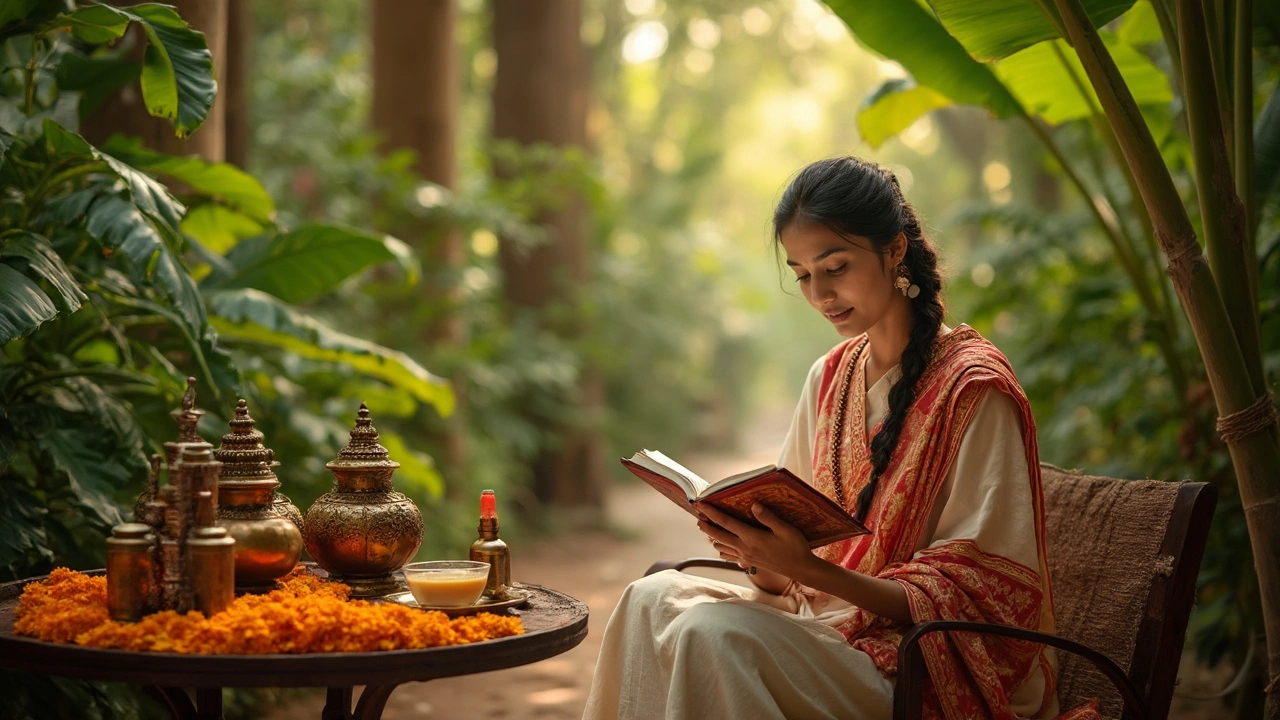-
4

Ayurvedic Massage: What Is It and How Does It Work?
Ever wondered why people rave about Ayurvedic massage, even if they can barely pronounce it? It's not just another spa trend. Ayurvedic massage is a full-on mind-body treatment that goes way beyond loosening tight muscles. It’s about tuning your whole system using ancient ideas from India, tailored to what your body actually needs.
Instead of the usual scented oils and basic back rubs, this massage uses special herbal oils chosen for your unique body type—what Ayurveda calls your ‘dosha.’ Therapists actually consider things like your digestion, sleep, and even mood before picking which oil to use. That’s why no two sessions feel exactly the same.
If you’re expecting gentle strokes and polite spa music, get ready for a surprise. Ayurvedic massage isn’t afraid to get hands-on, often using firm pressure, long sweeping strokes, and even some vigorous rubbing to wake up your skin, muscles, and energy. Some treatments focus on your scalp, ears, or even pouring warm oil (if you opt for shirodhara). Basically, every move has a purpose: to help clear out toxins, boost circulation, and balance everything from your mood to your metabolism.
- What Sets Ayurvedic Massage Apart
- The Role of Oils and Herbs
- What Happens During a Session
- Health Benefits and Science
- Tips for Trying Ayurvedic Massage
What Sets Ayurvedic Massage Apart
When you hear Ayurvedic massage, don’t picture the same old Swedish or deep tissue routine. What really makes it stand out is that it’s based on your personal mind-body makeup. In Ayurveda, everyone has a unique combination of energy types, called doshas: Vata, Pitta, and Kapha. Each person has a main dosha that guides their health, mood, and even how they respond to stress or food.
Before you hop on the table, an Ayurvedic therapist will usually ask about your sleep, digestion, skin type, and even weird daily habits. This isn’t small talk—it helps them pick the right oils and techniques for your session. If you tend to feel cold and dry, they’ll use warming, heavy oils and slow strokes. If you run hot and get easily irritable, they’ll cool you down with lighter oils and calming moves.
Unlike Western massages that often just target muscle tension, ayurvedic massage is after bigger goals. It’s designed to move ‘ama’ (meaning toxins) out of your tissues to rev up circulation, support immunity, and bring your whole system back to balance. It even aims to boost your mental state, making stress and brain fog less of a burden.
Here’s a quick rundown of what sets it apart:
- Personalized to your dosha: Every part of the massage is adapted to your body and mind.
- Therapeutic oils: The oils are medicated with herbs that tackle your specific needs—think calming, energizing, or detoxifying.
- Focus on health, not just muscle relaxation: The goal is bigger than muscle relief; it’s about resetting overall balance and well-being.
- Whole body approach: It isn’t unusual to have oil applied to the scalp, ears, or feet for maximum benefits.
- Mind and emotion care: Many people report not just feeling less stiff, but also sleeping better or feeling lighter mentally.
According to a 2021 survey of wellness clinics in India, Ayurvedic massage was the most requested form of holistic therapy, with 62% of clients saying they experienced improved relaxation and energy after just two sessions.
The Role of Oils and Herbs
Here’s where Ayurvedic massage really stands out—the use of custom-blended oils and herbs. Oils aren’t picked at random. Each blend is made to match your dosha, which is basically your body’s type according to Ayurveda (Vata, Pitta, or Kapha). These oils go beyond simple moisturizers—they’re meant to soak into your skin and get deep into your tissues.
Common base oils include sesame, coconut, mustard, or almond, depending on what your skin and body need. For example, sesame oil is warming and grounding, making it a go-to for folks who feel anxious or cold. Coconut oil cools you down, which is perfect for anyone who runs hot or needs to calm irritated skin. Therapists can even throw in herbal extracts like ashwagandha (for calming), neem (for its skin-clearing benefits), or brahmi (to relax your mind).
- Vata dosha: Needs warming oils like sesame, plus calming herbs such as ashwagandha.
- Pitta dosha: Uses cooling oils like coconut and herbs like sandalwood or neem to balance heat.
- Kapha dosha: Benefits from lighter oils like mustard and energizing herbs like eucalyptus.
These aren’t just old stories; modern research has found that regular massage with these oils can help your skin’s protective barrier and even lower stress chemicals in your blood. A 2022 study from Mumbai’s Ayurveda Institute showed that abhyanga (the classic Ayurvedic oil massage) improved skin hydration by over 30% in eight weeks.
| Common Oil | For Which Dosha | Main Benefits |
|---|---|---|
| Sesame | Vata | Warming, grounding |
| Coconut | Pitta | Cooling, soothes skin |
| Mustard | Kapha | Stimulating, light texture |
So, your Ayurvedic massage isn’t just about technique—getting the oil right is half the magic. If you’re new to this, always tell your therapist about any allergies. And don’t worry, you won’t leave smelling like a salad—most oils soak in after a warm shower post-massage.

What Happens During a Session
Walking into your first Ayurvedic massage can feel a bit different from the usual spa experience. Forget the standard routine. You’ll usually start with a quick chat, where the therapist asks about your health, sleep, digestion, and stress levels. This isn’t small talk—they’re figuring out your dosha, which helps them choose the right oils and techniques.
Once the details are sorted, you’ll be asked to undress (usually down to your underwear or as comfortable as you like) and settle onto a massage table. Unlike regular massages, Ayurvedic sessions always use plenty of warm herbal oils. Don’t stress about the mess; towels and sheets keep things under control.
Here’s what usually goes down, step by step:
- Oil Selection: Warm oils matched to your body type are used. For example, sesame oil is common for the Vata type, while coconut oil might suit Pitta types.
- Application: The therapist starts spreading the oil all over your body, not just the back. This step can feel strange if you’re not used to it, but it’s vital for absorption and relaxation.
- Massage Techniques: Expect a mix of long strokes, circular movements on joints, and some focused pressure. Abhyanga (the classic Ayurvedic massage) uses rhythmic motions and coordination if done by two therapists at once.
- Special Focus: Sometimes, there’s extra attention given to the scalp, feet, or even ears. You might get a head massage or oil dripped onto your forehead (that’s shirodhara, if you’re feeling adventurous).
- Rest Period: After the massage, you’ll usually lie still for a few minutes, letting the oils sink in before showering off or wiping down.
One fun fact: sessions with two therapists are known as “four-hand massages,” and you’ll often find this in traditional clinics across Kerala. It’s a completely unique sensation and more rhythmic than a one-handed approach.
Session times can vary. Most Ayurvedic massage treatments last around 60 to 90 minutes, but shorter or longer options exist depending on the treatment plan. If you’re worried about time, check ahead. Also, keep in mind: unlike typical massages, the focus is on the entire body, not just problem spots.
| Session Element | Purpose |
|---|---|
| Personal Health Check | Match oils and methods to your dosha |
| Warm Herbal Oils | Increase absorption, nourish skin, aid detox |
| Full-Body Massage | Improve circulation, balance energy |
| Scalp/Head Treatment | Reduce stress, calm mind |
| Post-Massage Rest | Maximize oil benefits |
If you’re new to Ayurvedic massage, don’t be afraid to mention allergies or skin sensitivities ahead of time. Most therapists are happy to adjust the oils or pressure to fit your needs. You won’t walk out smelling like a health shop, but you’ll definitely feel more relaxed, balanced, and just a bit curious about trying it again.
Health Benefits and Science
People don’t book Ayurvedic massage just for the good vibes—it’s about real health perks, too. The main thing you’ll hear is stress relief. Regular sessions can leave you feeling calmer and less anxious, because all those long, rhythmic strokes actually help your nervous system chill out. Some early research, including a 2019 study from the International Journal of Basic & Clinical Pharmacology, found that even just one week of daily Ayurvedic abhyanga (oil massage) dropped stress and heart rate in healthy adults.
There’s more: because these massages use specific herbal oils and techniques, they also boost your skin health. The oils hydrate and may even help with rough patches or inflammation. Plus, with the deep strokes and pressure, it can help your muscles recover after workouts and ease minor aches. People with joint stiffness or chronic pain sometimes say they get actual relief when they go for regular sessions.
- Boosted circulation: The technique sends blood moving through your body, which might help you feel more energized and less achy.
- Improved sleep: The calming effect on your nerves can help you fall asleep faster and wake up feeling more rested.
- Better digestion: Massages around the belly and lower back, done the Ayurvedic way, may actually help with bloating or slow digestion.
- Immune support: Since Ayurvedic massage aims to flush out toxins (what Ayurveda calls “ama”), some folks believe it helps your body fight off sickness better—although solid proof is still in the works.
Here’s something interesting: a small clinical trial in 2017 compared standard Western massage with Ayurvedic massage for people with tension headaches. Results showed both worked, but the Ayurvedic group reported longer-lasting relief and bigger drops in stress scores.
| Potential Benefit | Evidence Strength |
|---|---|
| Lower stress | Strong |
| Pain relief | Moderate |
| Better sleep | Moderate |
| Improved skin | Good |
| Improved immunity | Limited |
While science is still catching up to a lot of the claims, what's clear is that Ayurvedic massage does more than just relax you. It has some legit health effects, especially for stress and muscle tension. And for anyone on the fence, the sheer feeling of being grounded after a session is worth a shot.

Tips for Trying Ayurvedic Massage
If you’re new to Ayurvedic massage, it’s easy to feel a bit lost, but a few simple tips can help you get the most out of your first session. Here’s what to know before you book:
- Research your therapist. Not every massage therapist is trained in Ayurveda. Look for someone who actually studied Ayurvedic techniques or was certified at an Ayurvedic medicine school.
- Know your dosha. Many places will ask about your body type (dosha) before you start. If you’re not sure what it is, most therapists will do a quick assessment. Honest answers about your lifestyle, health, and stress make a real difference because treatments get tailored for each person.
- Don’t eat right before. Arrive with a light or empty stomach if possible. Most traditional Ayurveda advice says a full belly and massage don’t go well together.
- Be open about allergies. Ayurvedic oils and herbal blends are plant-based, but always speak up if you’re allergic to anything like sesame, mustard, or coconut oil.
- Shower afterward (not before). The herbal oils used in Ayurvedic massage need time to soak in. Many therapists suggest leaving oils on your skin for at least 30 minutes after your session before showering to get maximum benefits. Wear old clothes to your appointment—they could pick up some oil.
- Ask questions. Wonder why sesame oil is slathered all over your back or why the strokes are so specific? Ask away. Therapists trained in Ayurveda actually want you to understand the process, so feel free to chat before and after your session.
Most people find it more relaxing when they know what to expect. Curious about what a session might cost or how often you should go? Here’s a quick look:
| Session Type | Typical Price (India) | Recommended Frequency |
|---|---|---|
| Abhyanga (full body oil massage) | ₹1500–₹3000 | Once a week for wellness |
| Shirodhara (oil on forehead) | ₹2000–₹4000 | Depends on stress/sleep needs |
| Marma Therapy (energy points) | ₹2000–₹3500 | As needed for aches |
If you live outside India, expect prices to be higher, but the basics are the same. Don’t try to squeeze in a Ayurvedic massage if you’re in a rush afterwards—plan some downtime so you actually feel the difference. And if you like the experience, ask your therapist about using simple oils at home between sessions. Building a habit is what gets those classic Ayurveda benefits to stick.